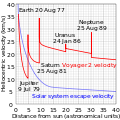Gravity assist
A gravitational slingshot, gravity assist maneuver or swing-by is the use of the relative movement and gravity of a planet to alter the path and speed of a spacecraft. This helps the spacecraft to save fuel, time, and expense. Gravity assistance can be used to speed up, slow down and/or change the path of a spacecraft. The "assist" is provided by the motion of the gravitating body as it pulls on the spacecraft.[1] The Soviet Union used it first for the Luna 3 probe that photographed the far side of the Moon. The later Pioneer program used gravity assist in several missions.
A gravity assist transfers kinetic energy from the gravitating body to the spacecraft. Energy cannot be created or destroyed, only transferred.
Gravity Assist Media
A view from MESSENGER as it uses Earth as a gravitational slingshot to decelerate to allow insertion into an orbit around Mercury
Plot of Voyager 2's heliocentric velocity against its distance from the Sun, illustrating the use of gravity assist to accelerate the spacecraft by Jupiter, Saturn and Uranus. To observe Triton, Voyager 2 passed over Neptune's north pole resulting in an acceleration out of the plane of the ecliptic and reduced velocity away from the Sun.
Animation of Rosetta's trajectory from 2 March 2004 to 9 September 2016 Rosetta · 67P/C-G · Earth · Mars · 21 Lutetia · 2867 Šteins
References
- ↑ http://www2.jpl.nasa.gov/basics/bsf4-1.php Basics of Space Flight, Sec. 1 Ch. 4, NASA Jet Propulsion Laboratory




